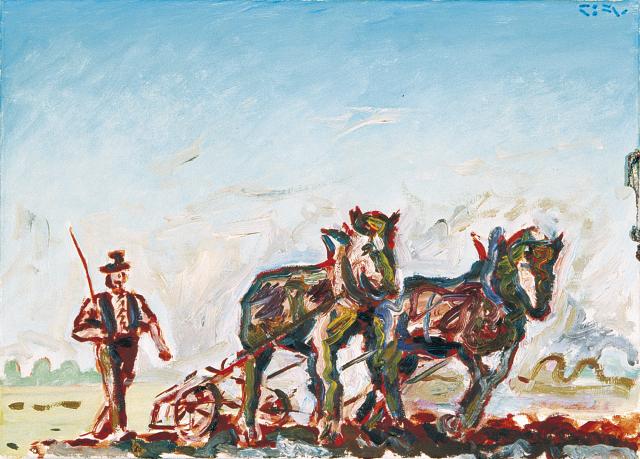Jean-Frédéric Schnyder treats modern painting styles as though they were reservoirs of artistic expression that he can dip into, possible vocabularies that are available for describing the world independently of their original historical anchoring. In the 1980s, the artist begins to use appropriation and quotation as the main tools of his practice.
A shrewd compiler working in small-format canvases, he paints images that are easily recognisable whilst their ambiguity generates frustration, i.e., they are simultaneously attractive enough to win over the viewer, too close to the old masters not to suggest a copy, and too small to achieve the sublime. And so we are confronted with Abend am Thunersee (Evening on the Shores of Lake Thun) from his series Landschaft (Landscape), which refers explicitly to Ferdinand Hodler and his renderings of Lake Thun painted at the dawn of the 20th century. Schnyder does a pastiche of his style but with a more relaxed, offhand touch, whilst conjuring up the archetypal image of Switzerland as a land of mountains and lakes.
With Fenster (Window), he reworks the many famous windows painted by Henri Matisse over the course of his career but reduces them to a simple pictorial anecdote, whereas Burebrot isch guet und gsund (Farmers’ Bread Is Good and Healthy) brings to mind the celebrated painting by Jean-François Millet, The Gleaners (1857). In the latter canvas, it is the whole of 19th century realist painting inspired by the peasants’ world that Schnyder is appropriating to fashion an iconoclastic Swiss-German version.
With Tierpark (Zoo), he plays ironically on the codes of heavy, thickly coated expressionism. Displaying a deft touch that imitates other painters’ workmanship but without the sophistication, Schnyder deliberately opts for a “painting without quality”, the kind practiced by the Sunday painter.
As a scholar who masters his choices and references, he works towards a true debunking of representation. Workmanship, style, subject or format, one or another of these elements always brings the painting back to day-to-day life, the banal, the present.
A shrewd compiler working in small-format canvases, he paints images that are easily recognisable whilst their ambiguity generates frustration, i.e., they are simultaneously attractive enough to win over the viewer, too close to the old masters not to suggest a copy, and too small to achieve the sublime. And so we are confronted with Abend am Thunersee (Evening on the Shores of Lake Thun) from his series Landschaft (Landscape), which refers explicitly to Ferdinand Hodler and his renderings of Lake Thun painted at the dawn of the 20th century. Schnyder does a pastiche of his style but with a more relaxed, offhand touch, whilst conjuring up the archetypal image of Switzerland as a land of mountains and lakes.
With Fenster (Window), he reworks the many famous windows painted by Henri Matisse over the course of his career but reduces them to a simple pictorial anecdote, whereas Burebrot isch guet und gsund (Farmers’ Bread Is Good and Healthy) brings to mind the celebrated painting by Jean-François Millet, The Gleaners (1857). In the latter canvas, it is the whole of 19th century realist painting inspired by the peasants’ world that Schnyder is appropriating to fashion an iconoclastic Swiss-German version.
With Tierpark (Zoo), he plays ironically on the codes of heavy, thickly coated expressionism. Displaying a deft touch that imitates other painters’ workmanship but without the sophistication, Schnyder deliberately opts for a “painting without quality”, the kind practiced by the Sunday painter.
As a scholar who masters his choices and references, he works towards a true debunking of representation. Workmanship, style, subject or format, one or another of these elements always brings the painting back to day-to-day life, the banal, the present.
